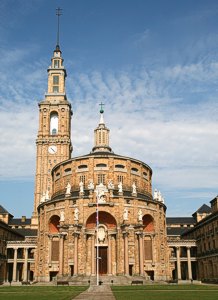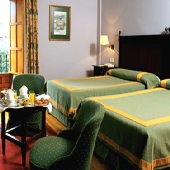
Gijon, Asturias, SpainOnce a Roman settlement, Gijon is now one of Spainís largest ports, and is located along the Bay of Biscay in the northern region of Asturia. With no less than 9 beaches along its shoreline it has become a popular summer resort area. Cruise ships can be seen bringing visitors in to enjoy not only the areas rich heritage but also its green and lush countryside. A natural headland divides the sea front, with the marina on one side and the Playa de Poniente beach on the other. The old quarter of Cimadevilla is the original fishing port, and built on a slope it has marvellous views of the sea. Centuries ago a wall once surrounded to protect it from attack. However, today the only evidence left of the wall is a ruin at the end of the headland and some old cannons. Your first port of call in the old quarter should be the impressive 18th century Revillagigedo Palace, now home to the cityís International Art Centre. Once Gijon gained status as a leading port, several palaces and beautiful manor houses followed such as the Campo Valdes and Ramirez de Jove. The promenade along the old port is a very pleasant walk and will take you past the original fishermanís houses. Other places of interest to look out for are the Church of San Juan Bautista and the Barjola Art Museum, a former mansion house dating back 400 years. If you are interested in a bit of Roman culture, seek out the Campo Valdes Roman Baths. With sections of the baths unearthed, visitors can also enjoy an interesting film, and an exhibit of models and drawings portraying Roman life. The Campa Torres Archaeological Park is just outside Gijon, and this is where you will find a pre-Roman hill fort dating back 2,500 years. Gijon has the benefit of several beautiful parks and gardens, such as the Cerro de Santa Catalina located above the Cimadevilla with wonderful views over the town. Just behind San Lorenzo, Gijonís largest beach, you will find the more formal gardens of Jardines del Nautico. If you would prefer woodland, decorated with flowers and ornamental features, there is also the Jardin Botanico Atlantico just outside the city centre. The oldest part of this particular garden dates as far back as 1870. The Universidad Laboral was designed by the architect Luis Moya Blanco, and originally intended as an orphanage for children of lost mine workers. What is interesting about this impressive complex is its truly eclectic mix of design. Now the Centre for Contemporary Art, it is open to the public and has a 117m high balcony tower with spectacular views of the city.  If you have time you should also try to visit the beautiful Lakes of Enol and Ercina, as well as the wildlife reserve of Muniellos. Particularly popular with hikers is the Picos de Europa mountain range and, on route to the mountains, you will pass the Cathedral of Oviedo and the Sanctuary of Covadonga.
If you have time you should also try to visit the beautiful Lakes of Enol and Ercina, as well as the wildlife reserve of Muniellos. Particularly popular with hikers is the Picos de Europa mountain range and, on route to the mountains, you will pass the Cathedral of Oviedo and the Sanctuary of Covadonga.
Late spring and early summer tend to be the best times to visit Gijon, and if you are there in June you will be just in time for the San Xuan festival. This is one of the cityís most popular events celebrating with a huge bonfire that is lit on midsummer night. The interesting mix of history combined with the vibrant atmosphere of Gijon is what makes it one of Asturia's most cosmopolitan cities. If it is luxury four star accommodation you desire, the Parador Gijon (Hotel Molino Viejo) will not disappoint you. The hotel is located in the Isabel la Catolica Park, one of the prettiest spots in town, and was originally an old Mill. Its ancient water course and beautiful mill pond creates a very tranquil environment, which is always welcome at the end of a long day. |